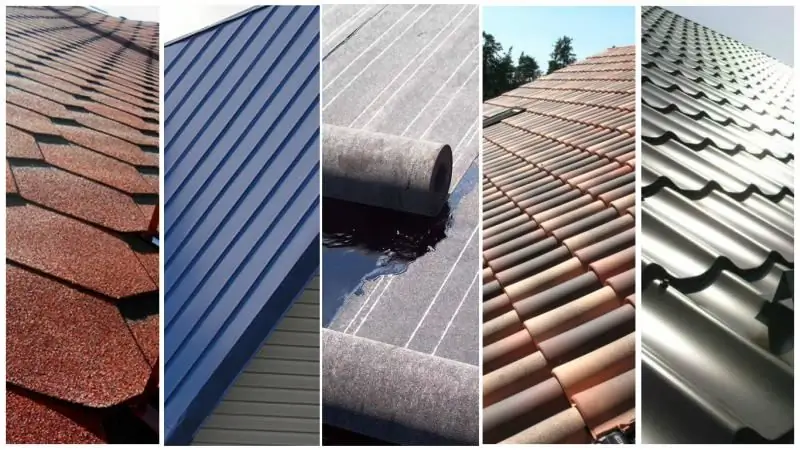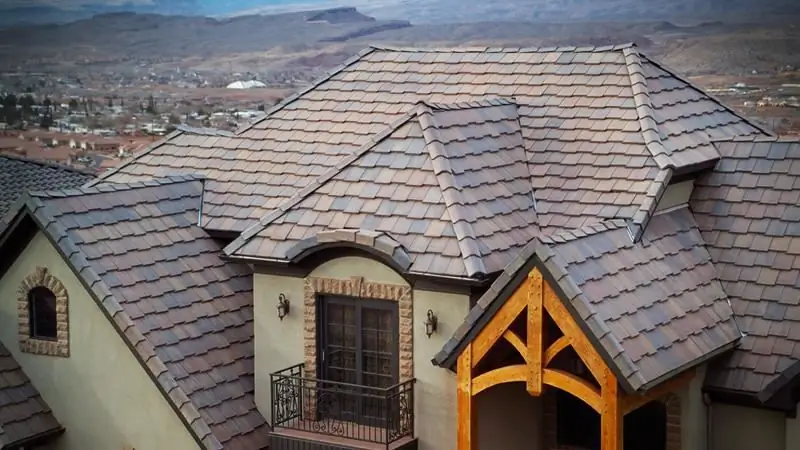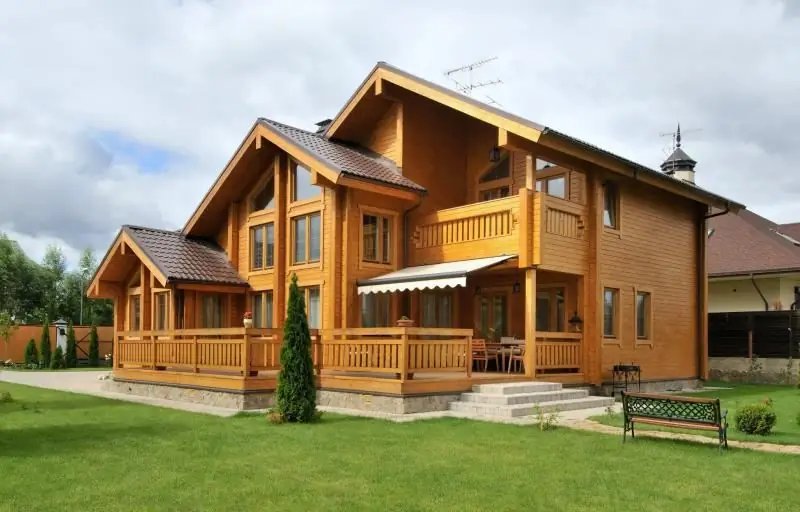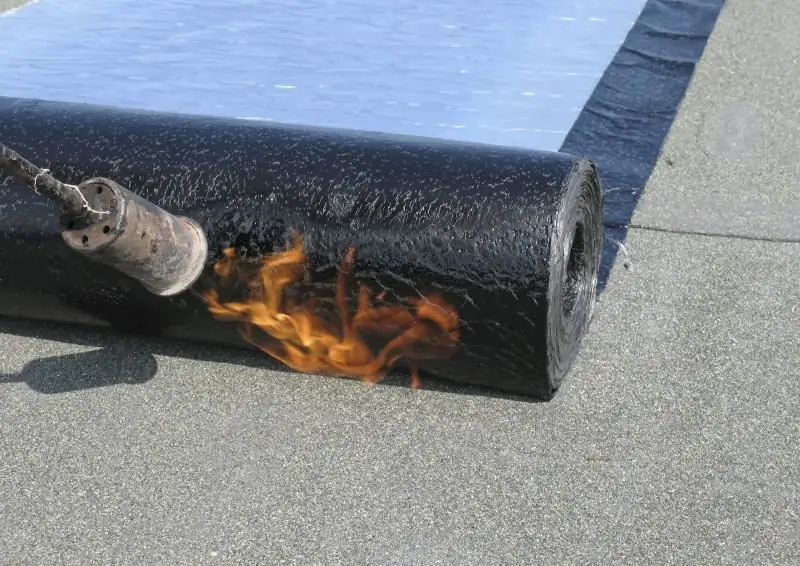
Table of contents:
- Author Bailey Albertson [email protected].
- Public 2023-12-17 12:53.
- Last modified 2025-06-01 07:32.
Types of roofing, their features and characteristics

An important step in building a house is creating a roof and choosing a roofing material. In addition to the fact that the roof protects the house from negative external factors, it is always in sight, therefore it must be beautiful and harmoniously fit into the design of the site.
Content
-
1 What roofs exist: features of each type
- 1.1 Seam roof
- 1.2 From metal tiles
- 1.3 From corrugated board
- 1.4 From ceramic and cement-sand tiles
- 1.5 Membrane
- 1.6 Weldable roof
- 1.7 Roll
- 1.8 Liquid roof
- 1.9 Inversion
- 1.10 Polycarbonate roof
- 1.11 From ondulin
- 1.12 Slate
- 1.13 Thatched roof
-
2 Types of roofs for private houses
2.1 Video: choosing a roof for a private house
-
3 Types of roofs for apartment buildings
3.1 Video: green roof on the roof of an apartment building
- 4 Reviews
What roofs exist: features of each type
Manufacturers offer a wide range of materials, so it is often difficult for home owners to decide what to use for the roof. And in order to make the right decision, one should understand the advantages and disadvantages of popular roofing coatings.

The roof can be protected with shingles, soft fusion materials, sheet metal and other coatings - you just need to make a choice for a specific case
Any roofing material must be waterproof, frost-resistant, meet the technical requirements for flexibility, heat and sound insulation.

There are many roofing materials available, but each has its own advantages and disadvantages.
When choosing a material for roofing, experts recommend paying attention to indicators such as:
- load on the roof - take into account snow and wind effects in a particular region, the weight of the roof together with insulation and lathing;
- architectural solution - to take into account the shape, size and slope of the roof, as well as to determine the optimal external design of the building;
- service life and fire resistance - take into account the purpose of the building: expensive and high-quality materials are usually used for the house;
- warranty obligations - some coatings have a much longer service life than the warranty.
Seam roof
For laying seam roofs, metal sheets (pictures) are used, which are fastened together with a special seam - seam. These connections are: recumbent and standing, single and double. The folds are folded and sealed with a hand or electric tool.

You can bend the folds yourself using a hand tool
When creating paintings, apply:
- galvanized steel - thickness within 4-7 mm, service life 25 years;
- polymer coated steel - galvanized sheet from the outside is covered with a layer of polymer with added color, service life 30-35 years;
- aluminum - lasts 70-75 years;
- copper is an expensive solution, but its service life is about 100 years;
- zinc-titanium - has the longest service life, but it is difficult to install. And the operation is carried out at an air temperature above 5 of C.

Seam roofing is characterized by high seam tightness and good moisture resistance
Such sheets are mounted on roofs with a slope exceeding 10 °. A crate or a solid base is made under them. Kleimers are used to fix the paintings to the crate. If the sheets are longer than 10 m, then they are fixed with "floating" clamps, which compensate for the thermal expansion of the material.

A rebated roof is reliable, but has its drawbacks during installation
Disadvantages of standing seam roofing:
- poor heat and sound insulation characteristics - a thick layer of insulation is required;
- installation requires special equipment and appropriate skills;
- metal surface - need protection against lightning (grounding).
From metal tiles
The metal tile looks like a natural one, but it is made of galvanized sheets processed with colored polymers. Such a coating is applied from the outside of the sheet, and from the inside it is varnished. It turns out a durable, beautiful and durable roofing material.

It is quite easy and quick to mount a roof made of metal tiles, even with your own hands
The main advantages of metal tiles:
- light weight;
- variety of colors;
- easy installation;
- resistance to temperature extremes, natural and mechanical influences;
- affordable price.
Among the disadvantages, there is an increased noise level during rain, if the installation was incorrectly performed and the roof is not sufficiently insulated.

Metal tiles are very similar to natural ones, but have less weight
There are several types of polymer coating:
- polyester is the most common option;
- polyurethane - increases the service life and cost of metal tiles;
- made of special polymer compounds - thickness 35 microns, it is optimal for the roof.
Sheets of metal tiles are mounted on the crate, the step of which is 35-50 cm.
To prevent condensation from accumulating on the roofing material, it is necessary to correctly assemble the roofing cake from a steam and waterproofing film, as well as two types of insulation.
From corrugated board
Roofing made of corrugated board in terms of characteristics and installation method is no different from metal roofing. The main difference is only in their appearance.

A roof made of corrugated board differs from metal tile only by a ribbed surface
Here, the crate is made in the same way and insulation is laid.
Sheets of corrugated board may differ in color, size, waveform and metal thickness.

You can cover not only the roof of your own house with corrugated board, but also the top of an ordinary city balcony
From ceramic and cement-sand tiles
Despite the fact that new roofing materials are constantly appearing on the market, natural tiles do not lose their popularity.

Ceramic tiles are also produced in the form of individual scales, which can be used to lay out patterns on the roof.
When choosing a covering made of natural tiles, it is important to take into account its high weight. Therefore, not only the truss system must be powerful, but also the entire supporting structure of the building: the foundation and walls. Another disadvantage is the fragility of the tiles, which complicates their transportation, unloading and installation.

Their different types of roof tiles are beautiful and outwardly neat.
Tiled roofing, when properly installed, is always reliable and beautiful. Despite the high cost of the material, such a roof is an excellent investment for the next 100 years.
According to the classification, ceramic tiles are divided into the following types:
- glazed - shiny and smooth, covered with a special glaze;
- natural - simply burned, is not covered with anything;
- engobered - matte and resistant to fading in the sun, covered with a thin layer of clay suspension.
Membrane
This is one of the varieties of soft roofing used on flat roofs. On such a surface, you can organize a recreation area and even plant lawn grass.

Membrane roof is quickly covered and easy to attach
Membrane thickness from 0.8 to 2 mm. It is delivered in rolls from 90 to 150 cm wide and up to 60 m long.

First, the membrane unfolds, and then it is attached to the surface in one of the ways
Advantages of a membrane roof:
- light weight;
- resistance to damage - thanks to the reinforcing mesh;
- high elasticity - practically does not decrease over time;
- resistance to sunlight;
- high fire resistance;
- simplicity and speed of installation - a team of workers can cover 500-600 m 2 per shift.
The main disadvantage of this coating: it is 30-50% more expensive than bituminous materials.

Membrane roofing is commonly used to cover flat roofs
Several materials are used to create the base:
- polyvinyl chloride (PVC);
- synthetic rubber (EPDM);
- thermoplastic polyolefin (TPO).
Membrane roof mounting methods:
-
ballast - if the roof slope does not exceed 15 o. Ballast (crushed stone, pebbles, gravel) is poured on top of the decomposed material or a cement-sand screed is poured. When using broken stone, mats or non-woven fabric (loose technical fabric) are additionally laid. Additional point fasteners are made around the perimeter and all junction points;

Ballast method of membrane roof mounting With the ballast method of mounting a membrane roof, it is difficult to find places of damage if a leak appears under the roof
- mechanical - when the roof structure is not designed for the weight of the ballast. The laid membrane is attached along the perimeter with special rails, and to the surface - with telescopic and disc holders;
- gluing is not a very reliable installation method, therefore it is rarely used. It is enough to stick the membrane around the perimeter, in problem areas and where there is an overlap: for this, double-sided adhesive tape is used;
-
welding by hot air - through special equipment is supplied air temperature of up to 600 of C.

Hot air welding of membrane cover Hot air welding of the membrane coating is carried out using an apparatus similar to a hair dryer: it simultaneously heats and dries the edges, therefore it can be used even in the rain
Surfacing roof
For flat roofs and slopes with a slight angle, weldable roll materials are used. And on the most complex roofs of any shape, soft tiles are used. The disadvantages of such tiles are the high price and the need to lay the elements on sheets of waterproof plywood. All weldable materials consist of bitumen, which, when heated with a special burner, adheres perfectly to the surface.

Soft bitumen shingles allow you to cover roofs of all kinds of shapes and configurations due to their small size and ease of installation
The tightness of such a roof and its service life directly depends on the quality of the welded elements and strict adherence to the installation technology. A soft roof can serve for 25 years. High operational characteristics of the overlaid roof are provided due to its complexity:
- Bottom layer: protects the roof from mechanical damage, sunlight and temperature changes;
- Second layer: made of bitumen, serves to protect against moisture;
- Base: made of fiberglass, ensures dimensional stability, does not allow the material to crack;
- Another layer of bitumen: for additional waterproofing;
- Top layer: slate or basalt dressing, protects the surface from damage.
The lower part of the material can be covered with fine-grained stone sand, polymer, slurry or foil. All characteristics of the overlaid roof can be easily recognized from its marking.

Bituminous shingles under the influence of the sun are additionally heated and glued into one common layer
When the roof slope greater than 15 on, then travel along the two layers of weld canvases if he 5-15 about , then need 3 layers.
Roll
Roll materials are used on roofs with a slope of 0 to 30 degrees.

Rolls for soft roofing began to be produced in different colors, which made it possible to design roofs in unusual combinations.
Roll roofing materials can be of two types:
- the main ones are made on a base impregnated with viscous mixtures. They can be tar, bituminous or bitumen-polymer;
- baseless - various fillers are added to the binders and combined by heat treatment into a single canvas.
By their structure, they are coverless and coverless.

Modern roll roofing can last 25-30 years
All roll roofing materials are divided into 4 generations of use:
- roofing felt and glassine - based on roofing cardboard. They are still popular due to their low cost, although their service life is about 5 years;
- rubemast is an improved roofing material: it is created by surfacing, which is convenient for self-assembly. It is laid easier and faster, but its service life is almost the same;
- glass roofing material - based on fiberglass or polyester. The service life reaches 15 years, and when laid in three layers - up to 30;
- membrane coating - service life over 30 years. Installation is carried out in a warm time: just remove the film, roll out the material and press it down.
Roll materials are fixed with roofing nails, bitumen mastic or a gas burner

A roof made of welded roll material lasts longer if the installation technology is followed
Liquid roof
Pouring a liquid roof can be used both when erecting a new roof, and as a repair of an old coating without dismantling the roofing materials.

Liquid roofing is done by self-leveling, painting and sprayed
The main advantage of this roofing is high reliability and long service life: liquid rubber is not afraid of temperature changes, resistant to mechanical damage and high humidity. You can walk on it without fear of slipping.
Types of liquid roofing:
- One-component: applied immediately after opening the container.
-
Two-component: consists of different parts:
- bitumen-polymer emulsion - provides waterproofing characteristics;
- an aqueous solution of calcium chloride - helps the sprayed solution to quickly solidify.
For the installation of the second coating, special equipment is required, in which two components are mixed at the outlet. It is a small unit, so it is convenient to use it on the roof. The applied composition hardens in a few seconds.

Application of a liquid roof during renovation increases the service life of the previous coating
According to the method of application, a liquid roof can be painted, sprayed or self-leveling. The base for liquid rubber is thoroughly cleaned. The composition is usually applied to a concrete or metal surface pre-coated with polyurethane. But also rubber can be sprayed onto roll roofs, improving its performance.

A thin layer of liquid rubber is sprayed over the roll roof, creating additional protection for it
Inversion
Inversion roofing is resistant to wear and tear and performs not only a protective function, but also has a functional and decorative purpose.
Such a roof is used on flat roofs and can be walked on. Its main feature is that in it all layers are arranged in the reverse order: thermal insulation is on top, and waterproofing is on the bottom.

On the inversion roof, you can arrange recreation areas, playgrounds and even parking lots
Inversion roofing is reliable, durable, does not collapse under the influence of negative external factors.

Inverted roofing in translation means "flip", that is, all the layers of the coating are reversed
An inverted roof can be of three types:
- for minimal loads - used in private houses;
- for medium loads - a more durable insulation is laid, and on top it is covered with paving slabs or other material;
- for increased loads - an intermediate reinforcing layer is added, then reinforced concrete slabs are placed.
If in a private house the installation of an inverted roof is carried out on a concrete slab, then first it must be primed, then waterproofing, insulation and the material to be welded should be laid.
Polycarbonate roof
Polycarbonate roofs are erected over terraces, verandas, balconies and other non-residential structures. For this, different types of the specified material are used:
- profiled polycarbonate - monolithic corrugated sheets;
- honeycomb (cellular) polycarbonate - honeycomb structure, the length of the sheets is 6 and 12 m, produced in color and transparent;
- monolithic (cast) polycarbonate - solid sheets without voids, they look like glass. They are multi-layered: the top layer is rough, the second serves to delay ultraviolet radiation, and the third ensures the strength of the material.

If high loads on the roof are expected, then it is better to lay thicker polycarbonate
Pros of polycarbonate:
- lightweight - does not require massive roof structures, is quickly mounted;
- transmits light well;
- colored copies add brightness to the interior of the building;
- flexible and resilient - large sheet sizes allow covering roofs of complex shapes;
- shockproof - does not break from any mechanical influences (falling branches, blows of stones);
- fireproof - fire does not spread over such a surface, it dies out;
- resistant to strong temperature changes.
Fastening of polycarbonate is carried out on special self-tapping screws with press washers. The thickness of the sheets is made different.
To create good illumination in the room, transparent polycarbonate is used, and when it is necessary to protect some space from overheating, then colored sheets with reflective additives are placed above it.

Colored polycarbonate canopy regulates heat transfer under the roof and serves as a shelter from the sun's rays by reflecting ultraviolet light
To build a roof of a certain shape, you first need to create a frame from metal or aluminum profiles, sometimes a wooden beam is used. But there are also special polycarbonate profiles: split and one-piece. And since they are also transparent, it seems that the structure is floating in the air.
From ondulin
In appearance, ondulin is similar to slate, but made of elastic material.
Ondulin advantages:
- practically zero water absorption;
- resistance to temperature extremes;
- protection from damage by fungus, mold and insects;
- resistance to chemically active substances;
- protection against loss of color in the sun;
- light weight;
- easy installation;
- long service life.
Ondulin and slate fit in the same way, but certain features still exist.

Installation of ondulin is carried out on a rare lathing, and if the roof slope is less than 10 degrees, then the wooden base is nailed tightly, without gaps
Laying of ondulin sheets is carried out in a staggered manner, the lateral overlap is done by 1-2 waves, and the longitudinal one - by 20-30 cm (it all depends on the slope angle). Special nails are used on a wooden frame, and self-tapping screws on a metal frame.
Slate
Slate is considered a budget material. It is durable, easy to fit.

Painted slate roof instantly renews the look of the entire home
Its popularity is due to the presence of such advantages:
- does not rust, does not conduct electricity, does not burn;
- during repair it allows you to replace one sheet;
- absorbs noise during rain;
- not warmed up by the sun's heat;
- serves for at least 30-40 years;

Gray slate is a common roofing material for small private houses.
But this material also has a number of disadvantages:
- fragile;
- heavy;
- absorbs water, cracks over time and becomes covered with moss;
- asbestos slate contains carcinogenic substances (it is better to use chrysolite-cement).
Slate sheets come with a different number of waves, but their length is always 175 cm. Installation of slate is performed on nails with wide flat heads.
Thatched roof
It is believed that the thatched roof is already a relic, but now in many elite houses this roof is used for covering. Also, not only straw can be used, but also reeds, heather, reeds. Such natural materials are highly flexible, which gives unlimited scope for design imagination.

Reed and thatch roofs look unusual and are used to decorate private houses
Thatched roof not only looks original and beautiful, it is also characterized by high heat saving.

Natural plant roof is a modern original solution with high performance
Do not think that a thatched roof ignites from any spark. Before use, the material is treated with a fire retardant, and its dense laying reduces fire safety to the level of other types of roofing.
The service life of a thatched roof is 50 years or more, which is more than that of a profiled sheet or metal tile. Experts recommend laying such a coating on roofs with an angle of at least 35 degrees. A natural roof does not require a ventilation system and perfectly absorbs sounds.
Types of roofs for private houses
A private house may have a flat or pitched roof, but the second option is usually found. In this case, the following types of roofing materials are used:
- piece - natural, composite, cement-sand or bitumen shingles, slate roofing;
- sheet - metal, profiled sheet, ondulin, slate, folded roof;
- vegetable - from reeds, reeds, straw, heather.
When choosing a roofing material for a private house, one must take into account not only its performance characteristics, but also its appearance in order to make the building beautiful and original.
Video: choosing a roof for a private house
Types of roofs for apartment buildings
If an apartment building is 1-4 floors high, then a pitched roof is usually made in it, so the same materials are used to cover it as in private housing construction.
In multi-storey buildings, the roof is always flat: rolled and welded materials are used to cover it, or a membrane roof is laid. If the surface of the flat roof is planned to be exploited, then an inverted roof is installed, on which you can walk and ride. Additionally, a liquid roof is used on the roofs of high-rise buildings: it perfectly protects against moisture, is durable.
Video: green roof on the roof of an apartment building
Reviews
Bottom line: there is a large selection of roofing materials, but they have not yet come up with an ideal one. To make the right choice, you need to familiarize yourself with the existing offers, determine the requirements for coverage and your financial capabilities. By choosing and laying the right roof, you can not only reliably protect the house, but also make it beautiful and unique.
Recommended:
Composite Tiles, Advantages And Disadvantages, Review Of Popular Brands With Descriptions, Characteristics And Reviews, As Well As Installation Features

Composite shingles: history of use, characteristics, pros and cons. Features of installation. Review of popular brands. Reviews of builders and home owners
Types Of Roofing Materials With A Description And Characteristics And Reviews, Including Roll, As Well As Features Of Their Operation

Types of roofing materials: sheet, soft and tile roofs. Technical characteristics and features of operation of various types of coatings
Roll Roofing Materials: Types With Descriptions, Characteristics And Reviews, Installation Features

What roll material to choose for the roof. How to mount it yourself. Use of self-adhesive materials. Dismantling old roofing
Waterproofing For Roofs With Distinctive Characteristics And Reviews, As Well As Installation Features

What is the waterproofing of the roof for? Types, brands, manufacturers of waterproofing materials. Hydro-vapor barrier laying technology. Consumer reviews
Types Of Attic Roofs With A Description And Characteristics, As Well As Features Of Installation And Operation

Features of different types of mansard roofs and installation rules. Tips for operating and repairing a mansard roof with your own hands
